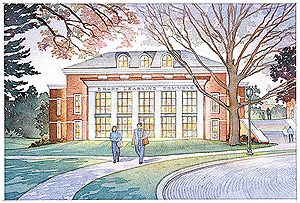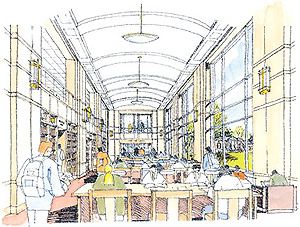
News Release
|
Office of News and Information Johns Hopkins University 901 South Bond Street, Suite 540 Baltimore, Maryland 21231 Phone: 443-287-9960 | Fax: 443-287-9920 |
December 8, 2008 FOR IMMEDIATE RELEASE MEDIA CONTACT: Tracey Reeves (443) 287-9903 treeves@jhu.edu |
Bill and Wendy Brody
The Johns Hopkins University will build a library expansion on its Homewood campus, a state-of-the-art building designed for technology-driven, collaborative learning and named the Brody Learning Commons, in honor of retiring President William R. Brody and his wife, Wendy.
The university's trustees announced the decision to honor the Brodys at a dinner for them over the weekend. They presented the couple with a framed artist's conception of the six-and-a-half stories building, which will be positioned to the south of the 44-year-old Milton S. Eisenhower Library, overlooking North Charles Street. The learning commons and the existing library will be separated above ground by a walkway and will connect below ground.
 |
| Above ground, the Brody Learning Commons will be separated from the MSE Library by a walkway; the two facilities will connect underground. |
Pamela P. Flaherty, chair of the board of trustees, said that the naming of the building is a tribute to the work the Brodys have done to strengthen community and reinvigorate student life on the Homewood campus. By greeting entering students and their families each fall, inviting them into their Nichols House home, attending games and other student events, and especially by presiding over the creation of new programs and facilities to enhance the undergraduate experience, the Brodys have enriched students' academic and social lives, Flaherty said.
"When Bill and Wendy announced their plans to leave Johns Hopkins, we were presented with a uniquely appropriate opportunity to honor their legacy of leadership," she said.
The Brody Learning Commons will cost roughly $30 million, all of which is coming from private donations and most of which has already been raised. The expansion, which university officials hope to complete by 2012, will be the first new-construction project on the Homewood campus to pursue LEED certification as a "green" building.
Winston Tabb, Sheridan Dean of University Libraries and Museums, said that the new building will not be quiet like traditional libraries. Rather, it will be a place where faculty, students and staff will be able to talk or even socialize openly — or steal away to quiet enclaves if they prefer. In essence, it will be a place that reflects the social way in which today's students and faculty learn, teach, network and interact, he said.
The announcement by the trustees is the beginning of a process that will engage Homewood students, faculty and staff in the final design of the project, university officials said.
"It's gratifying to know that at last the library expansion will move from dream to reality," said Steven Nichols, chair of the German and Romance Languages and Literatures Department in the Krieger School of Arts and Sciences. "Today's undergraduates were not yet born when folk realized the need for expansion. In the long run, though, we benefited from the wait because today we will be able to incorporate advanced technology that did not exist in the 1970s and '80s."
Zachary Epstein-Peterson, a junior classics major and a member of the libraries' student advisory council, said he is excited about the many uses of the planned building.
 |
| This concept drawing shows an airy, flexible space that responds to students' requests for natural light and multiple learning environments. |
"Given the recent upsurge in library usage by both undergraduates and graduates, as well as the technological nature of modern learning, the new learning commons should adapt to both of these changes, and this is a big part of why we are working on this project," Epstein-Peterson said. "Already we have discussed what we want to see incorporated — namely, natural light, big open rooms, multimedia/technology-based spaces and collections, an expanded café, group study space and others. These are just a few of the ideas that have been raised."
The expansion will be a collaborative learning space beyond the classroom and a focal point on campus. The building will be framed by large windows and feature a "librarylike" exterior. It will include space to display artwork and rare books and sculpture.
University officials said the "high-tech, high-touch" feel of the extension's interior will set it apart from Homewood's existing library, as well as other buildings on campus. The expansion plans call for the design to include such spaces as booths with chalkboard tables; project, video conferencing and interactive media rooms; a 3-D visualization room; a special collections classroom; and performance art space.
"The Brody Learning Commons provides an opportunity to build much-needed, imaginative new space to foster learning and advance the academic excellence for which the university is renowned," Tabb said. "With its premiere print and digital collections, the Eisenhower Library is well-established as an intellectual nexus on campus. The Brody Learning Commons will offer a new library environment, transformed by new technologies and comfortable spaces that support the flexible, collaborative learning experiences needed by students and faculty in the 21st century.
"My vision for the new library building is that it will enable the Sheridan Libraries to provide the best library and information services at any university in America — the kind of library our faculty and students want and deserve," Tabb said. "We will be even more fully embedded than we are now at the center of the intellectual, social and cultural life of the Johns Hopkins community."
The new structure will augment the existing library, a 185,000-square-foot facility built in 1964 and partially renovated in 1998 that will for the most part not change. University officials said they proposed the facility, which is on the Homewood master plan that was completed in 2000, largely because the existing library is overcrowded and does not provide enough space for students and faculty to collaborate. In addition, officials said that Johns Hopkins students have expressed a strong desire for light-filled and flexible spaces that cater to their diverse styles of learning.
A digital file of the artistís conception of the Brody Learning Commons is available. Contact Tracey Reeves.


 Go to
Go to